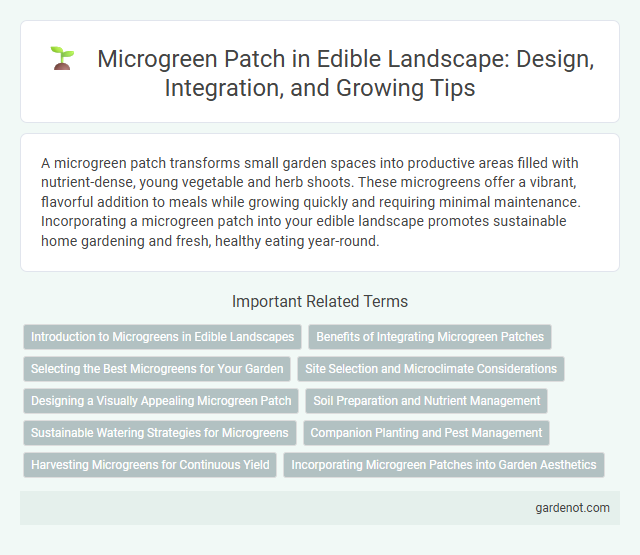A microgreen patch transforms small garden spaces into productive areas filled with nutrient-dense, young vegetable and herb shoots. These microgreens offer a vibrant, flavorful addition to meals while growing quickly and requiring minimal maintenance. Incorporating a microgreen patch into your edible landscape promotes sustainable home gardening and fresh, healthy eating year-round.
Introduction to Microgreens in Edible Landscapes
Microgreens are young, edible seedlings of vegetables and herbs harvested shortly after germination, typically between 7 to 21 days. Integrating microgreens into edible landscapes maximizes space efficiency, provides nutrient-dense produce, and enhances visual appeal through vibrant colors and diverse textures. Their rapid growth cycle allows for multiple harvests annually, making them an ideal choice for sustainable urban gardening and small-scale food production.
Benefits of Integrating Microgreen Patches
Microgreen patches enhance edible landscapes by providing a dense source of nutrients, including vitamins C, E, and K, while requiring minimal space and resources. Integrating microgreens boosts year-round food production with rapid growth cycles averaging 7-14 days, promoting sustainable urban agriculture. Their compact size and vibrant flavors enrich diverse culinary applications, supporting local food security and reducing carbon footprints.
Selecting the Best Microgreens for Your Garden
Selecting the best microgreens for your edible landscape involves evaluating growth speed, flavor profiles, and nutritional value. Popular varieties like sunflower, radish, and pea shoots offer vibrant colors, robust taste, and high concentrations of vitamins and antioxidants. Consider microgreens that thrive in your local climate and complement the overall aesthetics and edibility of your garden space.
Site Selection and Microclimate Considerations
Selecting a site for a microgreen patch involves prioritizing locations with well-drained soil and access to 4-6 hours of indirect sunlight, as microgreens thrive in moderate light conditions. Monitoring microclimate factors like temperature, humidity, and airflow is crucial; optimal temperatures range between 60degF and 75degF, while good ventilation reduces the risk of mold and fungal diseases. Understanding site-specific microclimate variations helps maximize growth potential and ensures consistent quality yields in edible landscapes.
Designing a Visually Appealing Microgreen Patch
Designing a visually appealing microgreen patch involves selecting a variety of vibrant, contrasting colors and textures to create an engaging edible landscape. Incorporating diverse microgreen species such as radish, sunflower, and basil enhances visual interest while ensuring a continuous harvest cycle. Strategic planting patterns and raised beds optimize both aesthetics and accessibility for efficient maintenance and enjoyment.
Soil Preparation and Nutrient Management
Preparing soil for a microgreen patch involves ensuring well-drained, nutrient-rich soil with a balanced pH between 6.0 and 7.0 to promote optimal seed germination and growth. Incorporating organic compost or vermicompost enriches the soil with essential nutrients like nitrogen, phosphorus, and potassium, crucial for the rapid development of microgreens. Regularly monitoring soil moisture and applying natural fertilizers such as fish emulsion or seaweed extract supports sustained nutrient availability and healthy microgreen production.
Sustainable Watering Strategies for Microgreens
Implementing sustainable watering strategies for microgreen patches involves using drip irrigation and capillary mats to minimize water waste and promote consistent moisture levels. Collecting rainwater and recycling nutrient-rich runoff further enhances eco-friendly water management while supporting healthy plant growth. These practices reduce water consumption by up to 50%, contributing to an efficient, sustainable edible landscape.
Companion Planting and Pest Management
Microgreen patches benefit significantly from companion planting by integrating selected plants that naturally repel pests, such as marigolds or basil, which enhance growth and reduce insect infestations without synthetic chemicals. Effective pest management involves monitoring microgreen trays for common issues like aphids and fungus gnats, and introducing beneficial insects like ladybugs or applying organic neem oil to maintain healthy, toxin-free crops. Combining companion planting strategies with vigilant pest control creates a sustainable, productive microgreen environment ideal for edible landscapes.
Harvesting Microgreens for Continuous Yield
Harvest microgreens when their first true leaves appear, typically 7 to 14 days after germination, to maximize flavor and nutrient content. Use clean, sharp scissors to cut the stems just above the soil level, promoting regrowth for multiple harvests. Maintaining consistent watering and proper light exposure ensures a continuous yield from the microgreen patch.
Incorporating Microgreen Patches into Garden Aesthetics
Microgreen patches enhance garden aesthetics by adding vibrant colors and intricate textures to edible landscapes, creating visually appealing and functional green spaces. Integrating microgreens such as radish, basil, and sunflower into pathways or borders offers a dynamic contrast that attracts pollinators and supports biodiversity. These compact, nutrient-dense plants promote sustainable gardening by maximizing limited space while providing fresh, flavorful greens for culinary use.
Microgreen patch Infographic

 gardenot.com
gardenot.com